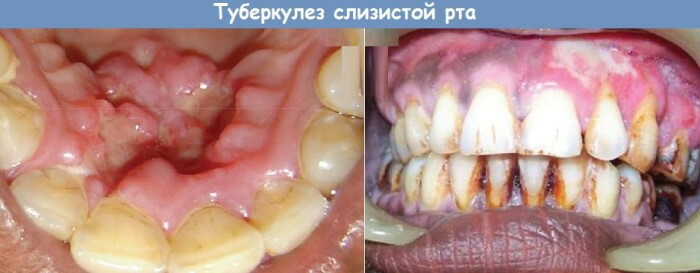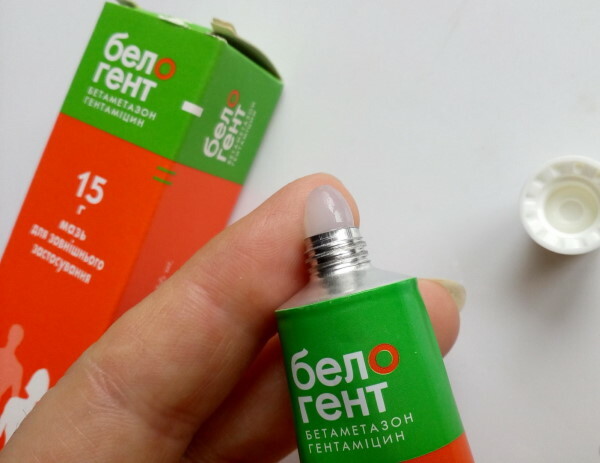Content
- General presentation of the apparatus
- Indications for use
- Pros and cons of installation
- How the device is installed
- The principle of operation of the device
- Features of the treatment process
- Wearing period
- Do I need braces
- Jaw Expansion Device Video
In dental practice, the problem of malocclusion is encountered, when the dentition of the lower jaw is, as it were, pushed forward in relation to the arch of the upper one. The defect can be corrected in adult patients, but correction of mesial occlusion (occlusion) is easier to carry out in early childhood.
To protect the child from conservative orthopedic correction methods, dentists suggest installing a special apparatus designed to expand the bones of the upper jaw. The procedure is performed in the clinic, it will not be painful for the child, and treatment in childhood will ensure the aesthetics of the appearance in the future.
General presentation of the apparatus
In the classic version, an orthodontic device is an intraoral plate device made from an individual impression (imprint) of the teeth. For the duration of the treatment, the apparatus is fixed on the chewing teeth with additional support on the canines. The central part of the plate is equipped with a screw with which the orthodontist sets the degree of expansion of the maxillary space.
A mechanically operating device for one jaw includes the following structural elements:
| Part name | Purpose |
| Hirex screw | Guides on both sides of the screw allow the force required to expand. |
| Rings | The devices are fixed on temporary molars (abutment teeth) in order to ensure fixation of the apparatus. |
| Metal paws | The hooks together with the rings create additional force, resting against the surface of the temporary canines. |
| Base part | The two halves of the plastic plate combine the components of the treatment device into a single system. |
The design of a non-removable apparatus that quickly expands the palatine vault was invented by the Italian doctor Marco Rossa. Thanks to the modification of orthodontist Andrew Haas, the titanium screw mechanism was replaced by a more powerful and durable Hirex screw.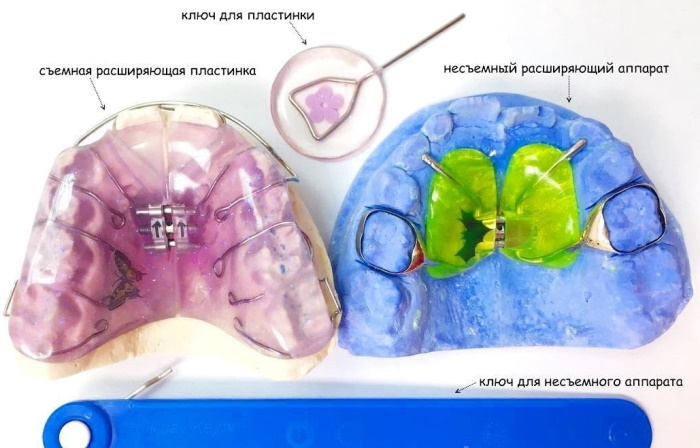
Based on the clinical situation, the system can be modified to suit the individual characteristics of the patient's jaw. For example, if the baby teeth had to be removed prematurely, the retaining rings (support) are fixed on the permanent (sixth) teeth. The next modification of the device can be the addition of dental pads.
The uniqueness of the Ross-Haas apparatus is the ability to expand the space of the upper jaw in very young children. The procedure allows you to correct the skeletal structure of the face in case of improper closing of the jaws, which in the future will save a small patient from speech disorders, problems with biting and chewing food, the appearance of open or cross bite.
Indications for use
The device for expanding the jaw for children has optimal periods of use. The greatest efficiency of correction is achieved at a time interval of 7-9 years, when the child's bite changes.
The therapeutic effect of the orthodontic system is due to the structure of the maxillofacial structure - the cartilage of the palatine suture unites the two halves (right and left) of the upper jaw. By acting on the malleable cartilaginous junction, skeletal expansion is achieved by stretching stimulation.
Indications for wearing a special plate are some types of pathological changes in the dentoalveolar structure associated with the narrowness of the upper jaw:
- defect of the mesial bite, when the lower jaw externally dominates in relation to the upper jaw, overlapping it;
- the fact of a sharp narrowing of the frontal segment of the upper dentition, which interferes with the eruption of permanent teeth;
- limitation of the motor ability of the language, which turns into a violation of speech function;
- problems with breathing through the nose due to the narrowness of the nasal passages, leading to the formation of mouth breathing;
- signs of underdevelopment (micrognathia) of the maxillary row due to diseases (rickets, endocrine pathologies), trauma, early loss of milk canines.
The installation of a non-removable palatal expander allows you to form the correct parameters of the upper jaw in children, remove the blockage of the lower jaw, and correct the cross-type bite. The result of the treatment is the enlargement of the nasal passages, which gives the child back the benefits. nasal breathing, and the incisors (upper, central, lateral) receive additional space for growth. This restores the articulation and position of the tongue.
Pros and cons of installation
The narrowing of the upper jaw occurs for a number of reasons, including a genetic predisposition, malfunctioning of the facial muscles, which is noticeable by the constantly open mouth. The cause of pathological changes in the jaw structure can also be the presence of polyps, adenoids, allergic edema, which lead to the formation of oral respiration.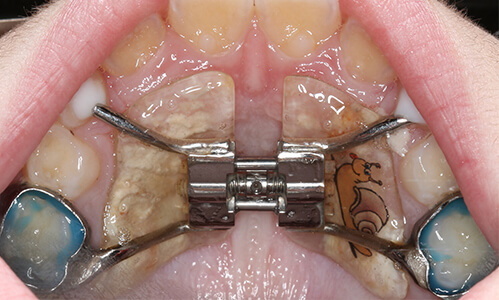
The device for expanding the jaw for children at the stage of active growth of the skeletal system successfully solves the problems caused by the narrowness of the upper jaw.
The installation of a non-removable expansion plate has several advantages:
- compared to a removable expander, the Ross-Haas apparatus is installed for at least six months without the need to remove;
- the treatment process is not particularly painful, does not require active help from the little patient;
- can be installed at an early age, when the bite is being formed, which increases the efficiency of the correction of dental defects;
- ease of setting the expansion rate due to the choice of the angle of rotation of the screw (more or less) and the option of its activation (daily or at intervals);
- as a result of wearing the plate in the space of the dentition, a place is prepared for the eruption of permanent incisors.
Of the negative aspects of orthodontic correction, patients note the need for nightly cleaning of the apparatus with an irrigator from stuck food. In addition, after the next meal, the child will need to rinse his mouth. Failure to comply with the rules of hygiene can lead to the development of an inflammatory process, therefore, parents at first will have to monitor the implementation of hygiene procedures.
During the first days of wearing the device, children can be capricious, diction disorders become noticeable, there are slight problems with chewing and swallowing food against the background of profuse salivation. The appearance of irritation on soft tissues in the places where the structure adjoins to the mucous membrane in the mouth is not excluded. The quality of care for the apparatus and teeth also requires parental control in order to exclude the development of complications.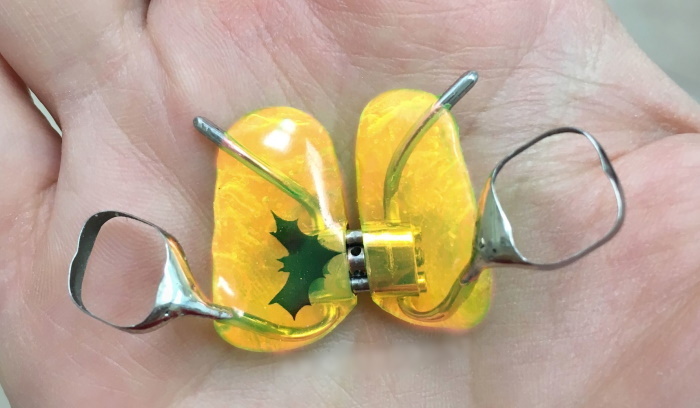
Do not be afraid of the appeared distance between the teeth in the center of the upper jaw. This is a normal situation during activation of the mechanism, since the skeletal framework of the upper jaw is in the process of growth. The resulting distance between the incisors located in the center (diastema) is considered an indicator of correct treatment. As the bone structures stabilize, the traces of the interdental spaces are redistributed.
How the device is installed
A simple device called a Ross apparatus is essentially a non-removable plate with a plastic base fitted with metal arms. The main part of the medical device is the screw, it is its activation that ensures the work of the plate, which expands the space of the upper jaw. When installing the plate, it is fixed on temporary molars, securing it with orthodontic rings. For installation on the canines of the upper dentition, dental material is used.
The device designed to expand the upper jaw is installed by the dentist of the dental clinic. Although the procedure can be frustrating for children, it is the parent's job to explain to the child the undeniable benefits of the treatment.
For installation, you will need to visit the orthodontist twice. At the first appointment, the doctor examines the results of an orthopantomogram in order to get an idea of the location of the teeth of both jaws, including those that have not erupted. Then the orthodontist will make an impression (impression) of the teeth, which is necessary for the customization of the corrective system.
During the second appointment, the finished device will be installed on the upper jaw of a young patient after cleaning the surface of the teeth from plaque and tartar marks.
The installation scheme for a non-removable orthodontic structure is as follows:
- the plate, together with the rings, is processed with special children's cement, which provides temporary fixation;
- after installation in the mouth, the rings are tightly fixed on the molars, and the legs cover the occlusal surface of the canines and are fixed with cement;
- after removing the remnants of the composite material, the doctor cleans the interdental gaps with dental floss;
- to ensure polarization (hardening) of the composite, the places of its application are illuminated with a lamp.
The installation is completed by activating the screw, which expands the palatine suture, and eventually the skeletal structure of the upper jaw. Some parents are intimidated by the need for daily manipulation of the screw on the plate using a special wrench. However, it is the responsibility of the orthodontist to teach adults this simple process. Within 3-4 weeks, the screw will completely unwind, and to achieve immobility, the doctor will flood it with a special substance to stop unwinding.
The principle of operation of the device
The work of the fixed device is based on the expansion force created by the Hirex screw. Due to the rotation of the main active element, the plastic base (plate) moves apart in the horizontal plane with the transfer of force to the elements of the dentition along the rings and legs. The result of the pressure created by the screw is the opening (gradual) of the palatine suture, due to which the upper jaw expands.
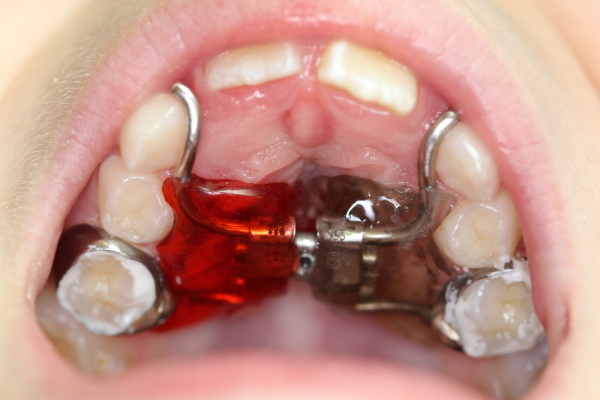
The jaw extension device for children is comfortable to wear. Patients do not feel pressure on the palatine arch and at the site of the alveolar processes, because the device only touches the palate. It is impossible to forget to put on or lose a device of constant influence, and the small size of the plastic base will provide quick addiction with minimal distortion of diction.
In addition, young patients have the opportunity to choose the color of the plastic for the base, make the device according to an individual design.
The non-removable expander is activated by a special hook equipped with a pin (small pin), which allows you to move the screw to the desired distance by turning.
The non-removable design provides two types of expansion:
- fast - daily activation of the screw;
- slow - with an interval of several days.
According to experts, more stable results are obtained by the slow expansion option, despite the long wearing period. When choosing a forced regimen, the active phase of treatment will take a month, but the device will have to be worn for about a year without activation to maintain the effect.
Features of the treatment process
Although the hardware effect is directed only to the upper jaw, quite often the treatment has a positive effect on the condition of the mandibular dentition. The reason for the expansion of the jawbone and the improvement of the position of the teeth from below is associated with the start of the self-regulation process in the lower jaw after releasing it from the clamp due to the narrowness of the upper one.
In most cases, the narrowness of the upper jaw is usually accompanied by other disorders and anomalies of the dentition - excessive development of the mandibular bone, problems with diction and oral breathing.
To increase the efficiency of the plate, it is advisable to combine the expansion process with the following procedures:
- wearing a special mask on the face - its extraoral design, equipped with a chin pad, slows down the development of the lower jaw;
- periodic visits to the ENT doctor, who must monitor the restoration of respiratory function if the child breathes through the mouth;
- visits to a speech therapist are necessary to correct the speech and swallowing process, as well as the position of the tongue so that it does not press on the teeth.
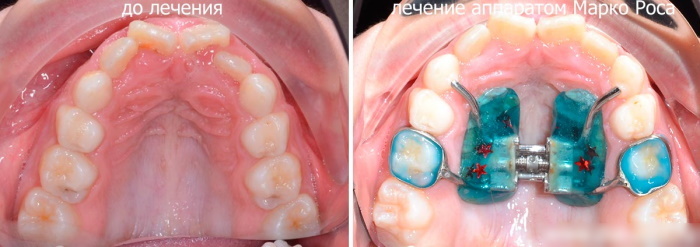
It is thanks to the complex treatment of narrow jaw problems that it is possible to save the child from the undesirable consequences of an orthodontic anomaly. Experienced orthodontists recommend installing a non-removable device at a time when the sixth teeth (permanent molars) have just begun to erupt in children, but the incisors have already come out completely (6-9 years).
A device for expanding the jaw for children is not only an opportunity to correct bite and restore nasal breathing, but also to prevent the growth of adenoids. Therefore, it is important that children regularly visit an orthodontist who can detect a skeletal anomaly in time. This is the key to preventing future health and mental problems.
Wearing period
As the child grows up, ossification of the palatine (middle) suture occurs, which imposes age restrictions on the use of the expanding device. Treatment with a non-removable palatal dilator guarantees the restoration of the shape of the upper jaw, if it is installed up to 9-10 years.
To consolidate the achieved result of expansion, wearing the Ross-Haas apparatus, invisible from the outside, will take at least six months. If the fast option is chosen, the period of wearing the device that does not damage the tooth enamel is significantly reduced.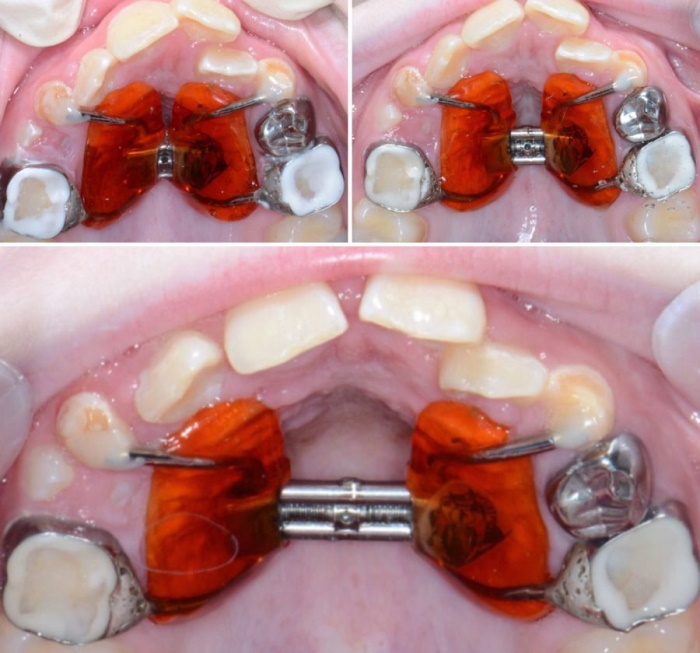
Experts recommend starting bite correction in children under 9 years of age. During this period, the skeletal bones did not lose the ability to deform, which will facilitate the correction of the upper jaw. However, taking into account the clinical characteristics of young patients, the installation of the Ross-Haas apparatus will be effective even at the age of 11-12.
Do I need braces
Of the family of fixed orthodontic appliances for occlusion correction, the safest and most time-tested devices are most often used - braces. A special design with plates, which is worn around the clock, is a curved arch that repeats the correct shape of the dentition.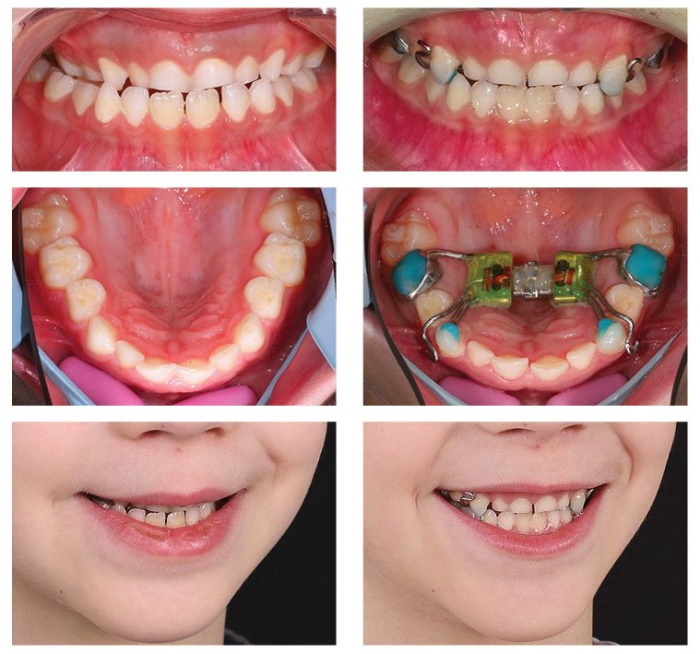
With the help of small locks, the plates of the bracket system are fixed on each tooth with an adhesive material, creating a pressure of a certain force. This effect helps to straighten the curvature of the jaw.
In the process of correction, the doctor corrects the tension and shape of the arch, the duration of wearing braces depends on the condition of the teeth and can last for several years. However, before the treatment of the bite with a fixed plate, it is impossible to determine exactly whether a bracket system will be needed in the future. It all depends on how successful the work of the expander will be, as well as on the peculiarities of the development of the maxillary apparatus.
Eventually:
- with the complete elimination of the abnormal bite, braces will not be needed;
- if the defect is partially eliminated, the bracket system will have to be worn.
If the narrowness of the upper jaw is detected on time and the orthodontist has installed a hardware retractor, the number of indications for installing braces is noticeably reduced, and the period of wearing them is reduced by several months. Parents' refusal to install an apparatus for the timely expansion of the upper jaw turns out to be necessary for children in adulthood to carry out surgical treatment of an underdeveloped dentition.
During the operation, which lasts about an hour, an expanding structure is introduced into the space of the bone tissue of the palate. Since the surgery is performed on a fully formed dentoalveolar structure, the surgery is performed under general anesthesia.
Jaw Expansion Device Video
Upper jaw extensions:


